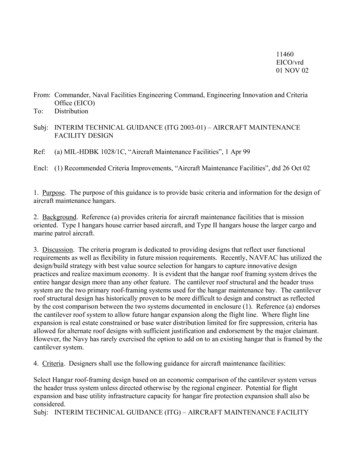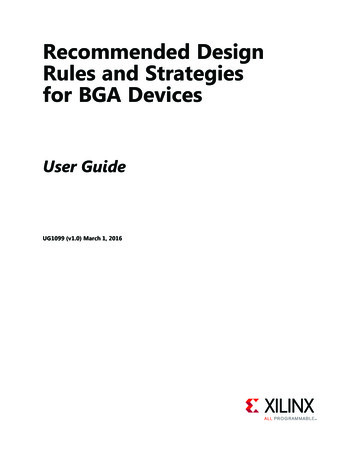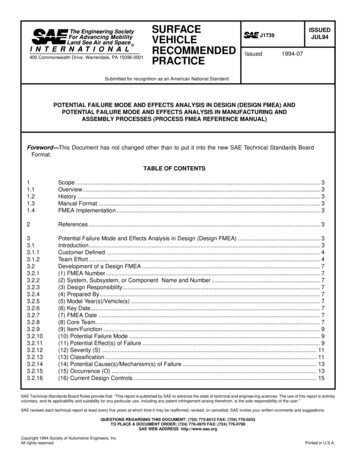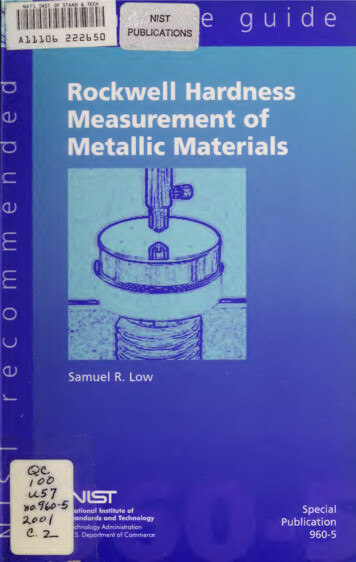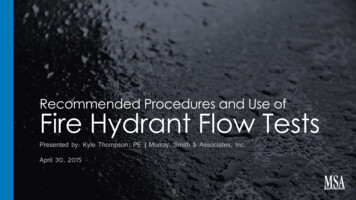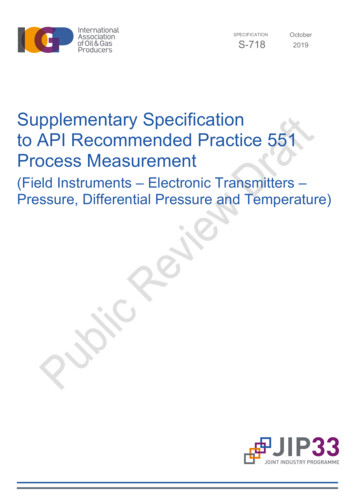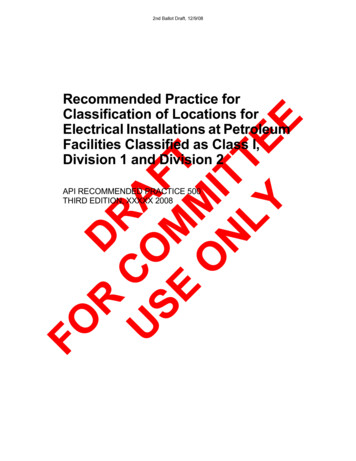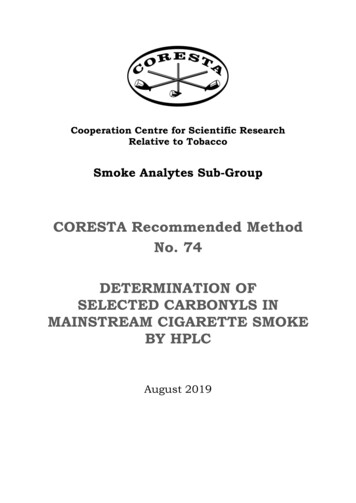
Transcription
Cooperation Centre for Scientific ResearchRelative to TobaccoSmoke Analytes Sub-GroupCORESTA Recommended MethodNo. 74DETERMINATION OFSELECTED CARBONYLS INMAINSTREAM CIGARETTE SMOKEBY HPLCAugust 2019
CORESTA RECOMMENDED METHOD Nº 74Title:DETERMINATION OF SELECTED CARBONYLSIN MAINSTREAM CIGARETTE SMOKE BY HPLCStatus: ValidNote: CRM developed into ISO 21160Document history:Date of reviewInformationAugust 2011Version 1March 2013Version 2July 2014Version 3February 2018Version 4August 2019Version 5CRM No. 74 – August 2019Page 2/24
CORESTA RECOMMENDED METHOD N 74DETERMINATION OF SELECTED CARBONYLSIN MAINSTREAM CIGARETTE SMOKE BY HPLC(August 2019)0.INTRODUCTIONAt the outset of this work, discussions in the CORESTA Special Analytes Sub-Groupdetermined that most laboratories used a method involving derivatisation of carbonyls with2,4-dinitrophenylhydrazine (DNPH) because they considered it the most suitable and so thiswas chosen as the basis of the Recommended Method. The method comprised smoke collectionin impinger traps, derivatisation of carbonyls with DNPH followed by their determination usingreversed phase High Performance Liquid Chromatography with Ultra Violet or Diode ArrayDetection (HPLC-UV or HPLC-DAD).Initial Joint Experiments and on-going discussions addressed some methodological aspects thatneeded to be evaluated before drafting a Recommended Method. The CORESTARecommended Method (CRM) was produced through a Collaborative Study undertaken in2010 involving 15 laboratories from 11 countries using the ISO 3308 smoking regime (Intorpet al., 2012). Further data are provided for the same selected carbonyl compounds from 10samples with different tar yields from a Collaborative Study in 2012 using both the ISO 3308and Health Canada T-115 (HCI) smoking regimes, which involved 19 laboratories from 11countries. This method includes recommendations about some of the critical steps that shouldbe controlled to provide data as robust and consistent as the repeatability and reproducibilitydata provided in the CRM. Statistical evaluations were carried out according to ISO 5725recommendations.At that time, when the collaborative study was conducted, the study protocol stipulated the useof Health Canada Official Method (T-115) for Intense conditions as there was not an ISOstandard that defined Intense smoking conditions. ISO 20778, Routine analytical cigarettesmoking machine — Definitions and standard conditions was published in 2018 and isequivalent to Health Canada Intense conditions and is referenced hereafter.1.FIELD OF APPLICATIONThis method is applicable to the determination of selected carbonyls (formaldehyde,acetaldehyde, acetone, acrolein, propionaldehyde, crotonaldehyde, 2-butanone and nbutyraldehyde) as their 2,4-dinitrophenylhydrazones in mainstream smoke from cigarettes withISO NFDPM yields between 1 mg/cigarette and 15 mg/cigarette using reversed phase HPLCUV/DAD.The described method is specified using ISO 3308 and ISO 20778 (Intense) smokingparameters. The use of these machine smoking parameters reflects their inclusion in thereporting requirements of various national regulations rather than an endorsement of theirappropriateness by CORESTA.CRM No. 74 – August 2019Page 3/24
2.NORMATIVE REFERENCES2.1ISO 3308:2012Routine analytical cigarette-smoking machine – Definitions and standard conditions2.2ISO 3402:1999Tobacco and tobacco products – Atmosphere for conditioning and testing2.3ISO 3696:1987Water for analytical laboratory use – specification and test methods2.4ISO 4387:2008/Amd 1:2008Cigarettes – Determination of Total and Nicotine-free Dry Particulate Matter Using aRoutine Analytical Smoking Machine2.5ISO 5725-1:1994Accuracy (trueness and precision) of measurement methods and results – Part 1: Generalprinciples and definitions2.6ISO 5725-2:1994Accuracy (trueness and precision) of measurement methods and results – Part 2: Basicmethod for the determination of repeatability (r) and reproducibility (R) of a standardmeasurement method2.7ISO 8243:2013Cigarettes – Sampling2.8Health Canada Official Method T-115: December 1999Determination of "Tar", Nicotine and Carbon Monoxide in Mainstream Tobacco Smoke2.9ISO 20778:2018Cigarettes - Routine analytical cigarette-smoking machine — Definitions and standardconditions with an intense smoking regime3.METHOD SUMMARY3.1Cigarettes are smoked on a smoking machine as specified in either ISO 3308 or in ISO20778 that has been fitted with impingers, but without the specified filter pad holdercontaining the glass fiber filter (e.g. Cambridge Filter Pad, CFP, or similar product).3.2The carbonyls in mainstream tobacco smoke are trapped by passing each puff through animpinger device containing an acidified solution of 2,4-dinitrophenylhydrazine (DNPH)in acetonitrile.3.3An aliquot of the smoke extract is then syringe-filtered and diluted with 1 % Trizma base in aqueous acetonitrile.3.4The samples are subjected to analysis using reverse phase HPLC-UV or HPLC-DAD.4.APPARATUS AND EQUIPMENTLaboratory apparatus and equipment, in particular the following items: Equipment for conditioning of tobacco productsEquipment for butt length markingEquipment for smoking of tobacco products complying with ISO 3308:2009Impingers for trapping mainstream smokeCRM No. 74 – August 2019Page 4/24
Erlenmeyer flasks (150 ml) with ground glass stoppers (or equivalent for combiningimpinger solutions)Polyvinylchloride tubing appropriate for connection of the trapping system, dimensions1/4” ID 3/8” ODLaboratory equipment for the preparation of samples, standards, and reagents - examples: Analytical balance, capable of measuring to four decimal placesAmber glass volumetric flasks 10 ml, 25 ml, 200 ml, 1 l, and 2 lGlass micropipettes – 50 μl, 100 μl, 150 μl, 300 μl, 400 μl, 500 μl, 800 μl, 1000 μl and2000 μlVolumetric pipettes – 1 ml, 2 ml, 5 ml, 6 ml, 7 ml, 8 ml, and 20 mlGlass graduated measuring cylinders 25 ml, 50 ml and 100 mlDispenser capable of delivering 35 mlHot Plate/StirrerSyringe filter - 0,45 μm PVDF or equivalentDisposable syringes - 5 mlDisposable glass Pasteur pipettesRubber bulbsAutosampler vials, caps and Teflon faced septaHPLC system consisting of: Tertiary gradient pumpAuto-sampler with appropriate sampling loopUV and/or DAD detectorData Collection SystemLC column: 250 mm 4 mm, Reversed Phase (RP) C18 (5 μm), or equivalentDisposable Guard Column: 4 mm 4 mm, RP C18 (5 μm), or equivalentVacuum filterAmber glass bottles 1 l and 4 lDesiccator5. REAGENTS AND SUPPLIESAcetonitrile (MeCN) – HPLC GradeIsopropanol (IPA) – HPLC GradeEthyl Acetate – HPLC GradeTetrahydrofuran (THF) – HPLC GradeEthanol – HPLC GradePhosphoric acid (85 %)Deionised water (resistivity 18,0 MΩ.cm @ 25 C)Formaldehyde-DNPH (min. 99 %)Acetaldehyde-DNPH (min. 99 %)Acetone-DNPH (min. 99 %)Acrolein-DNPH (min. 99 %)Propionaldehyde-DNPH (min. 98 %)Crotonaldehyde-DNPH (min. 99 %)2-Butanone-DNPH (min. 98 %); methyl ethyl ketone-DNPH derivativen-Butyraldehyde-DNPH (min. 99 %)CRM No. 74 – August 2019Page 5/24
Tris-(hydroxymethyl)-aminomethane; (Trizma Base, ACS Reagent Grade).Note – for reader’s convenience, Trizma Base will be used throughout the document.2,4-dinitrophenylhydrazine (DNPH)Helium (UHP) – if necessary for sparging of HPLC system mobile phase or equivalentdegassing systemNote: All reagents shall be at least analytical grade.Warning notice: The solvents and chemicals used in this method are classified as toxic, highlytoxic, harmful, carcinogenic, mutagenic, sensitising, teratogenic, irritant, corrosive, easilyflammable and dangerous for the environment. The instructions specified in the individualmaterial safety data sheets concerning safe handling, storage and waste disposal as well asprotective equipment must be followed. For example, DNPH solutions must not be sonicatedas this can be explosive.6.PREPARATION OF GLASSWAREGlassware shall be cleaned and dried in such a manner to ensure that contamination fromglassware does not occur.Note: All possible sources of contamination shall be removed from the work area (e.g. acetone solventwash bottles).7.PREPARATION OF SOLUTIONSDNPH solution (using Phosphoric Acid) Add approximately 150 ml deionised water to a 200 ml volumetric flask, then carefullyadd 28 ml of 85 % phosphoric acid and mix the solution. Make up the solution to volume with deionised water. Weigh 6,8 g (0,024 mole) of DNPH (approximately 30 % water) into a 2 l amber volumetricflask and add 1 l of acetonitrile. Dissolve DNPH by alternately gently swirling andwarming the flask. Make sure there are no crystals remaining.Warning notice: Do not sonicate as a precipitation of DNPH may occur.Note: If using re-crystallized DNPH, weigh 4,8 g to achieve the same molality (Appendix 1) After the DNPH is dissolved, add 58 ml of the diluted phosphoric acid solution whilstgently mixing. Dilute to volume with deionised water. The colour of the solution willbecome bright orange upon addition of the deionised water.Note: The addition of water will cool the solution and may initiate the precipitation of the DNPH.Add the water slowly. Gentle heating and stirring may be required to maintain the solutionat room temperature and to prevent the precipitation of DNPH. If crystals appear do notsonicate. Store the solution in a 4 l amber bottle at room temperature in the dark to prevent orsignificantly reduce the chances of DNPH precipitation. This solution, if properly sealed,will remain stable for one week.Note: Perchloric acid was investigated in a joint experiment (Intorp et al., 2012) and no differenceswere observed in comparison to phosphoric acid.CRM No. 74 – August 2019Page 6/24
Trizma Base Dilution Solution (80:20 v/v, MeCN:1 % aqueous Trizma ) Dissolve 2,00 g of Trizma Base in 200 ml of deionised water in a 1 l volumetric flask.Dilute to volume with acetonitrile.Store in a 1 l amber bottle with Teflon-lined cap or equivalent at ambient temperature.8.8.1 PREPARATION OF STANDARDSHPLC Calibration Standards and Working SolutionsThe calibration should cover the concentration range of interest. The following calibrationsteps were found to be suitable for this purpose.8.1.1 Primary (1 ) Carbonyl Standards Weigh the hydrazones as described in Appendix 2 into individual 25 ml volumetric flasksand dissolve in acetonitrile. Record the concentrations of the free aldehyde equivalents inµg/ml.Note: When properly stored (sealed and refrigerated at 4 C), solutions are stable for up to one year.8.1.2 Secondary (2 ) Carbonyl Standards Pipette predetermined volumes (Appendix 2) of each primary hydrazone standard into a25 ml volumetric flask and dilute to the mark with acetonitrile.Note: Store at approximately 4 C. Stability and storage time should be checked by the laboratory.8.2. Carbonyl Working Standards Take appropriate volumes (0,050 ml to 10 ml) of the 2 carbonyl standard (8.1.2) and diluteto 10 ml with acetonitrile to prepare calibration standards with approximate carbonylconcentrations (Appendix 2). Transfer to auto-sampler vials.Note: Store carbonyl working standards refrigerated and prepare a fresh set of working standards every20 days.9.SAMPLINGSampling is performed in accordance with ISO 8243:2013.10. TOBACCO PRODUCT PREPARATIONConditioning of the cigarettes is done in accordance with ISO 3402:1999.11. SAMPLE GENERATION – SMOKING OF CIGARETTESThe smoking parameters for which the method has been studied are defined in ISO 3308:2012and in ISO 20778:2018 (Table 1).CRM No. 74 – August 2019Page 7/24
Table 1. Smoking Parameters for ISO and Intense Smoking Regimes Smoking regimePuff volume(ml)Puff frequency(seconds)Puff duration(seconds)VentilationBlocking (%)ISO 3308:2012356020ISO 20778:201855302100A cigarette-smoking machine complying with the requirements of ISO 3308 or ISO 20778is required with the following modifications as detailed below:Note: No filter pad is required in the set up and therefore puff count information is the only means tomonitor whether the smoking process is controlled. Assemble the carbonyl mainstream apparatus on the smoking machine without using thefilter pads and filter holders. Check and adjust the puff volume drawn by the smoking machine at all channels at thecigarette end of the port as described in ISO 4387 with the impingers and DNPH in line.Figure 1. Example of a suitable trapping systemThis shows two impingers, each containing 35 ml of DNPH solution.Note: It is recommended to check the trapping efficiency when validating this method under both theISO and Intense smoking regimes. To check the trapping efficiency of the method, add anadditional 3rd impinger and follow the method accordingly. Analyse each impinger individuallyfor the compounds of interest. If no compounds are detected in the additional impinger thenonly the prescribed number of impingers is required to trap all the carbonyls effectively,otherwise an additional impinger is required.When applying the Intense smoking regime with a higher smoke velocity (e.g. ISO 17,5 ml/sec; Intense 27,5 ml/sec), the trapping efficiency should be checked duringlaboratory validation in order to possibly adjust the volume of the trapping solution or introduceanother liquid trap.CRM No. 74 – August 2019Page 8/24
Note: To determine whether a leak has occurred in the smoking machine impinger setup, use a leaktester. If the fluid column does not maintain its position but drops then there is a leak in thesystem. The cigarettes are smoked according to ISO and/or Intense regimes with the followingmodifications:Note: The number of cigarettes smoked may need to be adjusted depending on smoking regimes toprevent analyte breakthrough (see Note above).Linear Smoking Two cigarettes are smoked per replicate for both ISO and Intense smoking regimes.Rotary Smoking Five cigarettes are smoked per replicate for both ISO and Intense smoking regimes.12. SAMPLE ANALYSIS12.1Preparation of Mainstream Smoke Extract Solution
2.5 ISO 5725-1:1994 Accuracy (trueness and precision) of measurement methods and results – Part 1: General principles and definitions 2.6 ISO 5725-2:1994 Accuracy (trueness and precision) of measurement methods and results – Part 2: Basic method for the determination of repeatability (r) and reproducibility (R) of a standard measurement method 2.7 ISO 8243:2013 Cigarettes – Sampling 2.8 .

